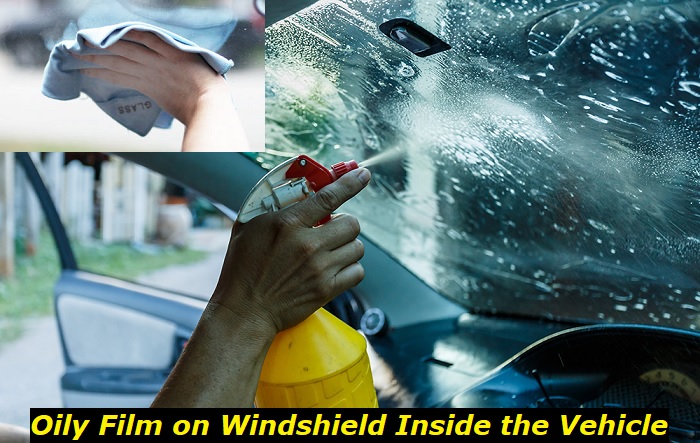Only a few things feel more annoying than the sound of squeaky windshield wipers. You are trying to clean water and this noisy sound keeps bothering your ears. The worst is that you can see what is wrong. It's the oily film on the glass that won't just surrender to cleaning.
Aside from the physical pain we all experience when the windshield wipe refuses to glide smoothly and silently, an oily windshield can be dangerous. It steals the driver's focus and this of course can cause an accident. The things get even worse when the oily film forms on the inside of the windshield.
How then do you get rid of this problem? We'll be looking at a few common reasons why an oily film might be on the inside of your windshield and what you can do to clean and prevent reoccurrence.

Why Is There an Oily Film on the Inside of My Windshield?
Let's make something clear. Seeing a clean glass surface does not always mean your windshield is clean. Glass surfaces can look clean when dry but the dirt becomes evident when you wipe the screen under a glare of light. And no, the windshield wipers are not to be blamed for this. Your wipers' primary function is to swipe away water, not remove grime.
Some car owners fall for this deception and continue to worry about why they can barely see through the windshield. It's not until they discover the dirt packed on the inside of the windshield that they realize what they are dealing with.
But why do car windshields get so gross in the first place? Here are some common reasons:
- Off-gassing
Remember that smell you noticed when you newly purchased your car? It was from the plastic and other interior components making up the vehicle. Over time, those break down and become trapped within the car, causing an oily film to form on the windshield. Other components of your car get affected by the broken-down components, but it's easier for the windscreen to catch a greater part of it.
Attempting to clean the surface using an oily cleaner only makes the situation worse. The cleaning solution evaporates into a film that coats the glass, especially in hot weather.
- Excessive touching
It's mostly unconscious but we have our hands over our car's windshield more often than we realize. This happens when you adjust the rearview mirror, reach out for something on the dashboard, or try to set up your GPS. Each time you do this, you are transferring the dirt and oil from your palm onto the glass, causing an oily film to form.
If you also like to rest your feet on the dashboard, you might as well prepare to deal with an oily windshield. This act not only leaves smudges on the inside of your windshield, but it is also a major safety hazard.
- Exiting your car
Chances are contaminants from outside step in with you every time you open the door to enter or exit your car. It's worse on windy days, but germs from the air outside can find their way into your car anytime you come in or go out.
You might wonder how much contaminants can be let in within such a quick duration but it adds up quickly. Imagine opening your car door 10 times each day, then multiply that by all the days you have to be out.
- Dirty cabin air filter
Your cabin air filter is supposed to reduce pollutants from the air you breathe within the car but sometimes, it just does the opposite. The accessory can start to blow debris onto your windshield when it becomes extremely packed with dirt.
Even with closed windows, the dust can come from the vent or air conditioning system. This is why cleaning the cabin air filter is always advised. Doing this regularly prevents dust particles from reaching the vents and transferring to your windshield. Consider changing your cabin air filter if you drive a lot in highly-polluted areas.
- Smoking
Vehicle interiors have the ideal environment to form a film that affects the inside of a car's windshield. Smoke from cigarettes or other sources combines with humidity and dust and that produces a mask. This mask ultimately covers the glass and can be tough to get rid of because of the toxins smoke contains.
- Leaking Engine Coolant
You can tell you have a leaking engine coolant if you start to perceive strong odors or notice the haze on the glass has a blue-colored hue. This leak can cause or worsen an oily film on the windshield. It mostly comes in through the vents.
Treat every kind of leakage seriously because the chemical can harm your health and make you feel uncomfortable in your car.
- Keeping Windows Down
This reason is quite evident. Driving with your car windows down generates more wind, and more wind means greater chances of dirt and grime making their way in. It's a similar situation as when you exit and open your car door several times a day.
- Rainwater
Sometimes, the oily film on the inside of your windscreen is caused by external factors. Rainwater, for instance, can combine with other substances and create calcium deposits. Leaks can cause the water to penetrate the car, producing an oily film. Hard water, acid rain, and tree sap are similar contributing factors here.
How to Clean Oily Film on the Inside of Your Windshield
How you go about cleaning your windshield depends on the degree of oily film you are dealing with. You might also need to clean more than once to ensure the film completely disappears.
Some people use readily-available solutions like a water and vinegar mix, rubbing alcohol, or glass-cleaning products. Others also report that products like shaving foam help form a protective layer that prevents oily windshields.
Remember that using the right cleaning tools is more important than mixing a lot of untested things. Here are the essentials you will need for cleaning:
- Microfiber towel
- Cleaning solution
- Rubbing alcohol
STEP 1: Clean the windshield
Wipe down the glass on the inside with a dry microfiber cloth to get rid of excess dirt on its surface. Missing this step can leave your windshield looking grimier, so don't ignore it simply because wiping hasn't been effective so far.
STEP 2: Apply rubbing alcohol
Using rubbing alcohol before using a window cleaner helps the cleaner work better. You need a small amount of rubbing alcohol so mix it with water in a 1:1 ratio. Apply it to a clean microfiber towel and wipe down the inside of the windshield.
STEP 3: Use The Cleaning Solution
Spray the chosen cleaning solution onto a microfiber cloth and wipe down the glass. Spraying it directly on the windshield can lead to overspraying. If the bottom glass is too hard to reach, try using a windshield cleaner wand.
Avoid using a dish-washing detergent as these tend to leave the glass feeling squeaky clean. Get a specialized product from an automotive shop instead.
STEP 4: Dry the windshield
The final step is to dry the windshield with a dry microfiber cloth so that the liquid is completely soaked in. Also, check the glass on the outside to be sure there are no water spots.
How Do You Prevent an Oily Film from Forming on the Inside of Your Windshield?
Routine cleaning will help keep your car's windshield from being masked by an oily film. Here are some other preventive measures to take:
- Limit or avoid smoking in the car: The act is one of the most common causes of build-up on a car's windshield. If you notice a yellow residue when cleaning the windshield, the film was likely caused by smoking.
- Use the right cleaning formula: Cleaning products containing ammonia can ruin your windshield especially if the glass is tinted. Ensure to get products specifically made for windshields for routine cleaning.
- Microfiber clothes: Wipe down your windshield using a microfiber cloth. This fabric type prevents streaks because of its soft texture.
- Top your windshield water reservoir with clean water to clear the glass while driving. Using soapy water can cause the solution to stick to your screen and compound the problem.
These tips, in addition to paying attention to the cause of the oily film and avoiding those practices, should help reduce grime and oil on your inner windshield.
Conclusion
Every driver has probably dealt with a blurry windshield at one point or another so quit worrying that the film won't come off. Follow the steps provided here and most importantly, make sure you are not repeating the practices that caused the issue in the first place.
Your car's windscreen having an oily film on the inside is never a situation to ignore as it limits visibility, so hopefully, you take the necessary steps as soon as possible.
About the authors
The CarAraC research team is composed of seasoned auto mechanics and automotive industry professionals, including individuals with advanced degrees and certifications in their field. Our team members boast prestigious credentials, reflecting their extensive knowledge and skills. These qualifications include: IMI: Institute of the Motor Industry, ASE-Certified Master Automobile Technicians; Coventry University, Graduate of MA in Automotive Journalism; Politecnico di Torino, Italy, MS Automotive Engineering; Ss. Cyril and Methodius University in Skopje, Mechanical University in Skopje; TOC Automotive College; DHA Suffa University, Department of Mechanical Engineering






Add comment